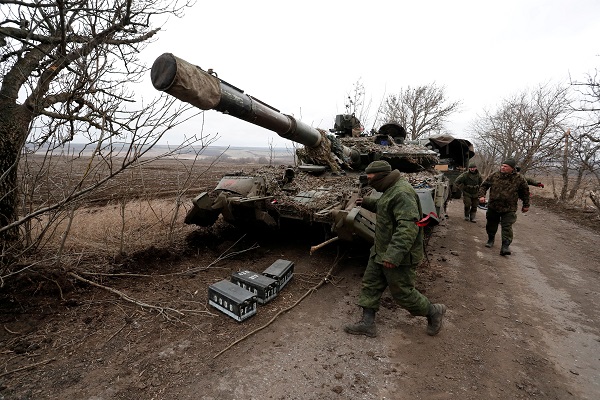 Pro-Russian separatists walk near an abandoned tank on a road between the separatist-controlled settlements of Mykolaivka (Nikolaevka) and Buhas (Bugas), as Russia's invasion of Ukraine continues, in the Donetsk region, Ukraine, 1 March 2022;
Credit: Reuters/Alexander Ermochenko/File Photo
Pro-Russian separatists walk near an abandoned tank on a road between the separatist-controlled settlements of Mykolaivka (Nikolaevka) and Buhas (Bugas), as Russia's invasion of Ukraine continues, in the Donetsk region, Ukraine, 1 March 2022;
Credit: Reuters/Alexander Ermochenko/File Photo
MOSCOW (Reuters) - Russian forces have captured the villages of Serebrianka and Mykolaivka in Ukraine's eastern Donetsk region, Russia's Defence Ministry said on Wednesday 23 October 2024, as military blogs reported Russian advances near key frontline towns.
Ukraine's military made no acknowledgement of either village falling into Russian hands, but said both areas of the front were gripped by intense fighting.
Bloggers on both sides reported an intense Russian drive on the town of Selydove.
The Ukrainian General Staff said its forces had repelled all twelve Russian attacks undertaken in an area around Serebrianka just inside the northern border of Donetsk region.
It said heavy fighting gripped towns on the approach to Pokrovsk, the next key logistical town in the Russian military's steady push westward in Donetsk region.
The popular Ukrainian military blog DeepState said Ukrainian troops were facing overwhelming odds defending Selydove - which lies southwest of Mykolaivka. Capturing Selydove would pave the way for a Russian advance on Pokrovsk.
DeepState said Russian forces with "the advantage of endless resources of infantry and equipment" were putting pressure on Ukrainian defences and advancing from both north and south.
Reuters could not independently verify battlefield reports from either side.
Russian military blogs earlier in the day reported fighting around Selydove and three other towns - Kurakhove and Hirnyk further south and Toretsk to the northeast.
Yuri Podolyaka, a Ukrainian-born, pro-Russian military blogger, said Russian forces had seized the central, eastern and southern districts of Selydove, once a town of 20,000. He posted a video he said showed a Russian flag atop a high-rise building.
Russian forces, sent into Ukraine in February 2022, advanced in September at their fastest rate since March 2022, according to open source data, despite Ukraine taking a swath of territory after an August incursion into Russia's Kursk region.








